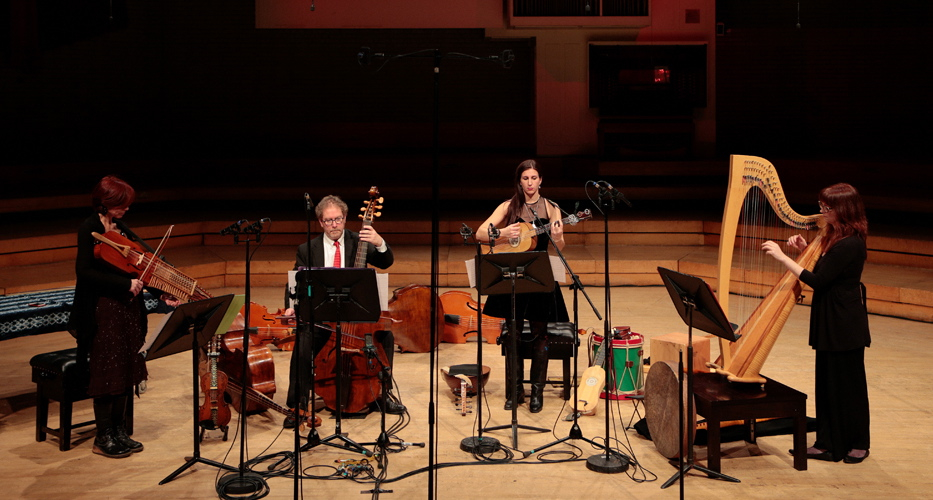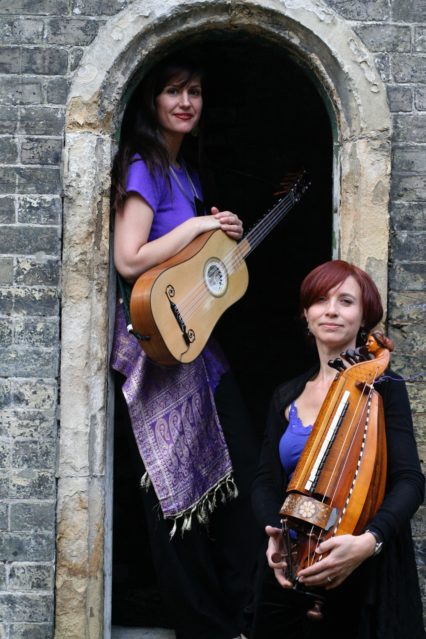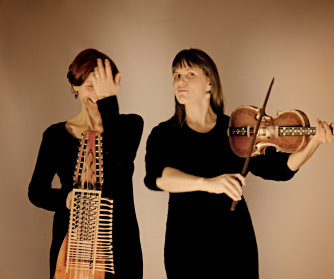Cath Barton attended the Brecon Baroque Festival, a concert celebrating Baroque music, featuring music from Ministry of Angels, a programme which follows the theme of Angels and Archangels.
Brecon Baroque Festival: Ministry of Angels
The Society of Strange and Ancient Instruments
Clare Salaman, director, hurdy gurdy, nyckelharpa
Clara Sanabras, voice, renaissance and baroque guitars, oud
Joy Smith, harps, percussion
Peter McCarthy, unusual bass instruments
Theatr Brecheiniog, 21 October 2018
Whether by design or happy accident, the theme of ‘Angels and Archangels’ chosen by Rachael Podger for her 13th Brecon Baroque Festival has embraced a visit from Clare Salaman’s delightful Society of Strange and Ancient Instruments. Their programme ‘Ministry of Angels’ was originally developed for a tour in 2012/13 by Salaman with Clara Sanabras and Joy Smith, now joined by bass player and entertaining raconteur Peter McCarthy.
All four of the musicians took their turn in describing the curiosities of the instruments they play, and this contributed greatly to the relaxed and inclusive mood of this concert. It is no easy feat to make a programme of music largely drawn and elaborated from mediaeval manuscripts coherent, but a combination of these musicians’ knowledge, skill and enthusiasm pulled it off.

Although much of this music deals with religious themes – and Salaman told us that she got the idea for its title from the groupings in the index of Hymns Ancient and Modern – the angels of mediaeval texts come in many guises, and the music they have inspired is never solemn. How could it be, when the instruments on which it is played include the hurdy-gurdy with its unattached buzzing bridge and the bray harp which, though shaped like an angel’s wing, some say sounds like a donkey. What I found fascinating was that these instruments are among those which we see angels playing in old pictures and carvings and here was a rare opportunity to hear them, in a celebration of all things angelic from the heavenly Cherubim and Seraphin to Lucifer, the fallen angel.

It is the angel Gabriel that is particularly associated with the birth of Christ, and in the first half of the concert he had the spotlight, in traditional tunes Joseph and the Angel and When righteous Joseph wedded was linked to Christmas Cheer and Doves Vagary from John Playford’s Dancing Master manual of 1651. The arrangements of these tunes for the various forces of The Society of Strange and Ancient Instruments lift them into technicolour.
Voice is one of the strangest and most ancient of instruments, and Clara Sanabras uses all the colours of hers, both in the textures woven by the group and, most movingly, unaccompanied in Lullay, lullay: Als I lay on Yoolis Night, sung in Middle English.
Angels are not just creatures of heaven and hell, but often found brought into earthly form as metaphors for love, loss and hope. The pavane Belle qui tiens ma vie (1589) by French cleric Jehan Tabouret writing under the pseudonym Thoinot Arbeau and celebrating the lover as angel, is often found in the repertoire of contemporary players of early music, but linking it to a Rondeau (1730) by the French composer and violinist Francois Francoeur intensified the sense of the dance of love. Little-known now, Francoeur’s music has an inventiveness and infectious rhythmic drive which made it popular in his lifetime.
For a section on ‘Guardian Angels’ the group included a chant for Christmas from the mediaeval Sarum rite and an extract from The Play of Daniel, an early liturgical drama thought to have been intended for performance at Matins on January 1st. It is marvellous that this music has survived – the Play of Daniel in a manuscript thought to be from around 1230, now in the British Library – though of course modern reconstructions use harmonies which may be quite different from those (if any) which were used originally. We cannot know. The same is true for the use of instruments. Peter McCarthy, in talking about his unusual bass instruments, showed us one for which precise tuning instructions remain, but no information about what was played on it!
I loved the way this concert combined and interwove music from different periods – the term ‘early music’ which could be loosely applied to the Ministry of Angels programme covered such a wide range, through the baroque in Corelli’s Follia variations to El recer del vol dispers, a beautiful piece composed by Clara Sanabras setting Catalan words from poems by her great grandfather, in which birds without a place to land are an angelic metaphor for loss and longing.
There is further exploration of Spain in the inclusion of two songs from the thirteenth century Cantigas of Santa Maria, about miracles of the Blessed Virgin in which angels play various roles. These strophic songs are epics, but the extracts sung and played by these musicians are sensibly chosen not to outstay their welcome.
This most entertaining programme concluded with a vision of angels in devilish form: one of the Cantiga extracts together with traditional English and French tunes, including the French Christmas carol in Burgundian dialect Guillô, pran ton tambourin (also known as Patapan).
Many of the pieces started with a single instrument, the music fanning out to include combinations of harps, strings, percussion and voice. The acoustic of Theatr Brecheiniog made it easy to differentiate the different timbres of the various instruments within the ensemble, from the sweet tone of the celtic harp through the more strident sounds of the hurdy-gurdy and the Swedish nyckelharpa and the soft ukelele-like renaissance guitar to the soulful oud, the classical lute-like instrument of the Middle East unchanged since mediaeval times.
I’m full of admiration for both the scholarship of these four musicians and the way they used it to make such apparently effortlessly joyful music, an excellent contribution to Rachel Podger’s inventive programme of angelic delights in this year’s Brecon Baroque Festival.
Header photo, Clara and Clare courtesy of The Society of Strange and Ancient Instruments
You might also like…
Cath Barton attended the Brecon Baroque Festival, a concert celebrating Baroque music, featuring music from A Guardian Angel, an album which follows the theme of Angels and Archangels.
Cath Barton is an English writer who lives in Wales. Her prize-winning debut novella The Plankton Collector is published by New Welsh Review under their Rarebyte imprint. Cath is on the 2018 Literature Wales Mentoring programme, working on a collection of short stories inspired by the work of Hieronymus Bosch. https://cathbarton.com @CathBarton1



 Enjoyed this article? Support our writers directly by buying them a coffee and clicking this link.
Enjoyed this article? Support our writers directly by buying them a coffee and clicking this link.







